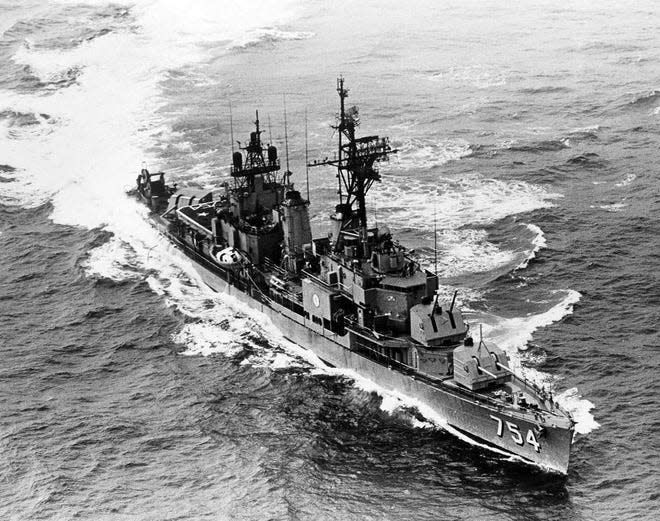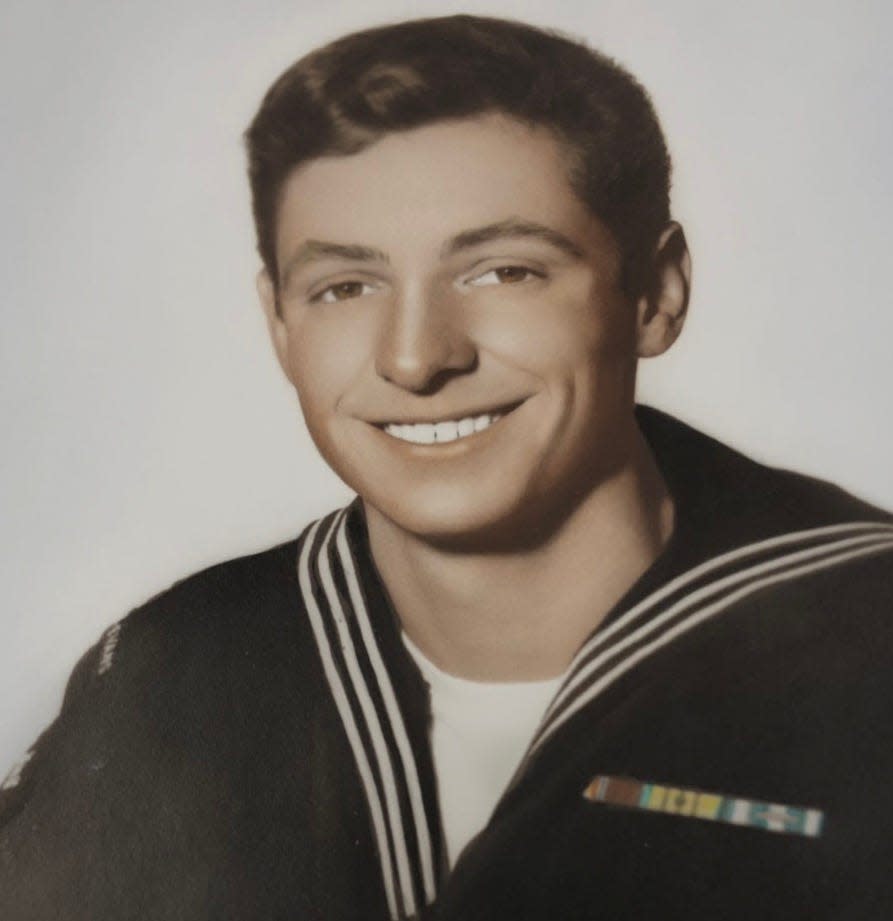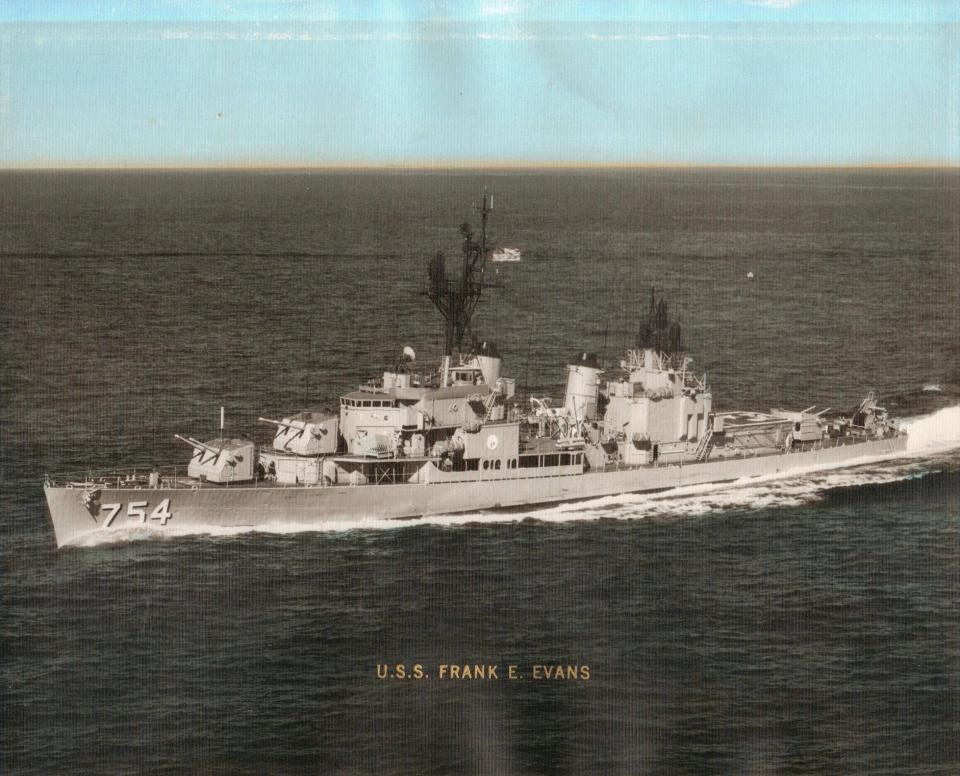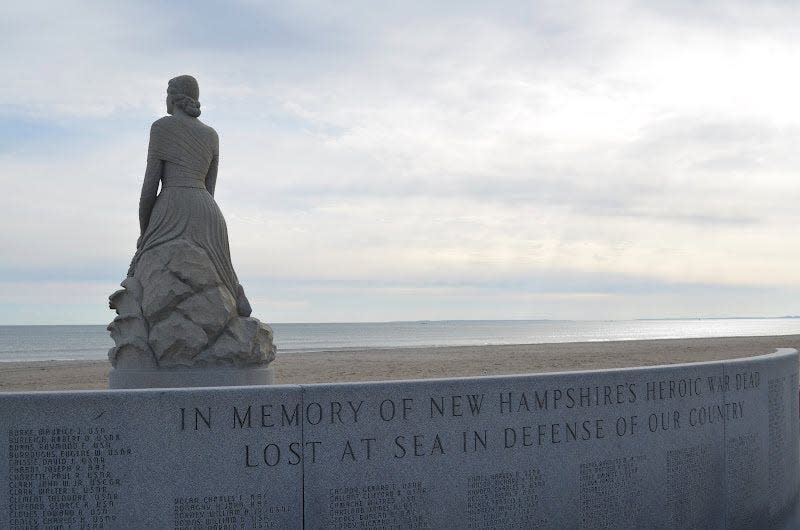NH natives who died in Lost 74 tragedy being added to Hampton Beach Lady of Sea memorial
HAMPTON BEACH — At 3:15 a.m. on June 3, 1969, two New Hampshire natives were lost at sea along with 72 of their shipmates in a tragic accident. The USS Frank E. Evans was cut in half by an Australian aircraft carrier during naval exercises in the South China Sea.
Fifty-four years later, at 8 a.m. on Saturday, June 3, their names, Radarman Second Class Ronald Thibodeau and Quartermaster Third Class Gary Vigue, will be added to the New Hampshire Marine Memorial at Hampton Beach. Known locally as the “Lady of the Sea,” the monument holds the names of 291 military men whose bodies were never recovered after being lost at sea.
“We hope the public will join us to honor these two U.S. Navy sailors,” said American Legion Post 35 Commander Berk Bennett. “I read two books on what happened. It was a terrible tragedy.”

Born in Manchester, Thibodeau’s family had moved to California by 1969. Vigue was born nearby in Dover, graduating from Farmington High School. Both men were in the bow of the destroyer when it sank after the collision. Both were married and both left behind young children.
Thibodeau’s son, Tim Wendler, is coming from California to speak at the ceremony, Bennett said, and other members of the two families are also expected to attend.
The story of the USS Frank E. Evans
The ship was commissioned in February 1945, serving in World War II, the Korean Conflict and Vietnam War. In 1969, the USS Frank E. Evans, according to published reports, had just left the gun line off Vietnam before she engaged in her final mission.
“We were out of bullets and out of supplies,” said Terry Vejr, an Evans survivor. “We put into the Philippines to replenish our stores, and were ordered to take part in the Operation Sea Spirit exercises.”
The destroyer joined the naval exercises along with dozens of other ships from South East Asia Treaty Organization nations.

The Evans was in escort to the Australian light aircraft carrier HMAS Melbourne, Vejr said, and with other ships was engaged in anti-submarine training exercises. In the early morning hours of June 3, at around 3 a.m., intending to launch aircraft, the Melbourne instructed the Evans to take a new position, or escort station.
According to Bennett, a former Navy pilot, the Evans intended to move behind the Melbourne, in position to rescue pilots from the sea on the carrier. However, there was confusion on the Evans’ bridge as to the ship’s position in relation to the Melbourne. That resulted in the Evans, according to reports, heading starboard (to the right), turning towards the carrier’s bow. The Melbourne warned the destroyer and took evasive action, but the Evans course put her in front of the Melbourne’s bow.

By 3:15 a.m., the aircraft carrier hit the smaller destroyer, Vejr said, slicing it in two. The bow sank in three minutes and 74 of the 273 crew were lost, most trapped below deck in their berths.
The Melbourne stopped immediately, Vejr said, and crews from both ships lashed the Evan’s floating stern to the aircraft carrier, while others rescued sailors from the sea.
“The Melbourne’s crew threw cargo nets and ladders over the side, so we could evacuate,” Vejr said, “It was a long way up. I didn’t know if I could make it.”
Simultaneously, life rafts were launched and helicopters searched the seas, Vejr said. Some Melbourne sailors dove off the aircraft carrier to rescue Evans’ mates swimming nearby, he said.
According to published reports, all survivors were rescued within half an hour, but the search continued for 15 hours.
“I survived because I was on watch on deck in the stern after-steering room,” Vejr said.
As horrible as the collision was, a strong bond developed between these seafarers from two nations, Vejr said, and before the Americans were transferred to the USS Kearsarge for the trip home, the Evans captain pulled his crew together to give “three cheers,” for the Australians, who’d worked to save their lives.
Controversy haunts the crew of the USS Frank E. Evans
Decades after the 1969 collision, however, a Department of Defense rule added insult to injury for the men of the Evans. DOD determined the names of the “Lost 74" wouldn’t be on the Vietnam War Memorial because they were outside the combat zone when they died.
The ruling was devastating, Vejr said, for his shipmates had served during the Vietnam War era, fought in Vietnam waters before the sea exercises and expected to return there afterwards.
“Every other American ship involved in Operation Sea Spirit returned to the Vietnam combat zone,” Vejr said. “I’m sure we would have, too.”

Bennett said the issue stems from the fact the Evans sank 225 miles from the Vietnam coast, which was 125 miles outside the DOD’s designated Vietnam combat zone.
Vejr said the USS Frank E. Evans Association works to change the DOD combat zone requirement so the “Lost 74" can be added to the Vietnam Wall. Annually, the association asks Congress to pass a bill to that effect, he said. So far, however, the bills have failed.
To memorialize their shipmates, the association works to establish memorials in their home states.
Remembered forever on Lady of the Sea
Oddly, it is the bond created between the two crews five decades ago that led indirectly to Thibodeau’s and Vigue’s names being added to the Lady of the Sea. That and a Granite State Navy veteran.
“The crews have annual reunions; last year’s was in Portland, Maine,” Vejr said. “We were sitting in the lounge of the hotel, all wearing our Frank E. Evans hats, and a man named Rob Biron walked over to ask us why we were there.”
“I was on a ship in the Indian Ocean during the Persian Gulf War,” said Biron, a lieutenant with the Manchester Fire Department. “We have reunions, too, but they had an amazing turnout.”

Biron said the story of the Evans sinking was horrible, and when he heard the sailors who died weren’t on the Vietnam Wall, he was outraged and wanted to help. Although he didn’t have luck on a federal level, after “many, many, many calls,” he was able to touch base with Hampton’s American Legion Post 35, resulting in a successful outcome in New Hampshire.
“If it hadn’t been for that reunion and Rob, this never would be happening,” said Vejr, who’s attending the June 3 ceremony along with Biron.
“We thank them for bringing this to our attention,” Bennett said. “We are very glad to be able to get these names on the monument, so they’ll be remembered forever.”
This article originally appeared on Portsmouth Herald: Two NH natives lost at sea to be added to Hampton Beach monument

